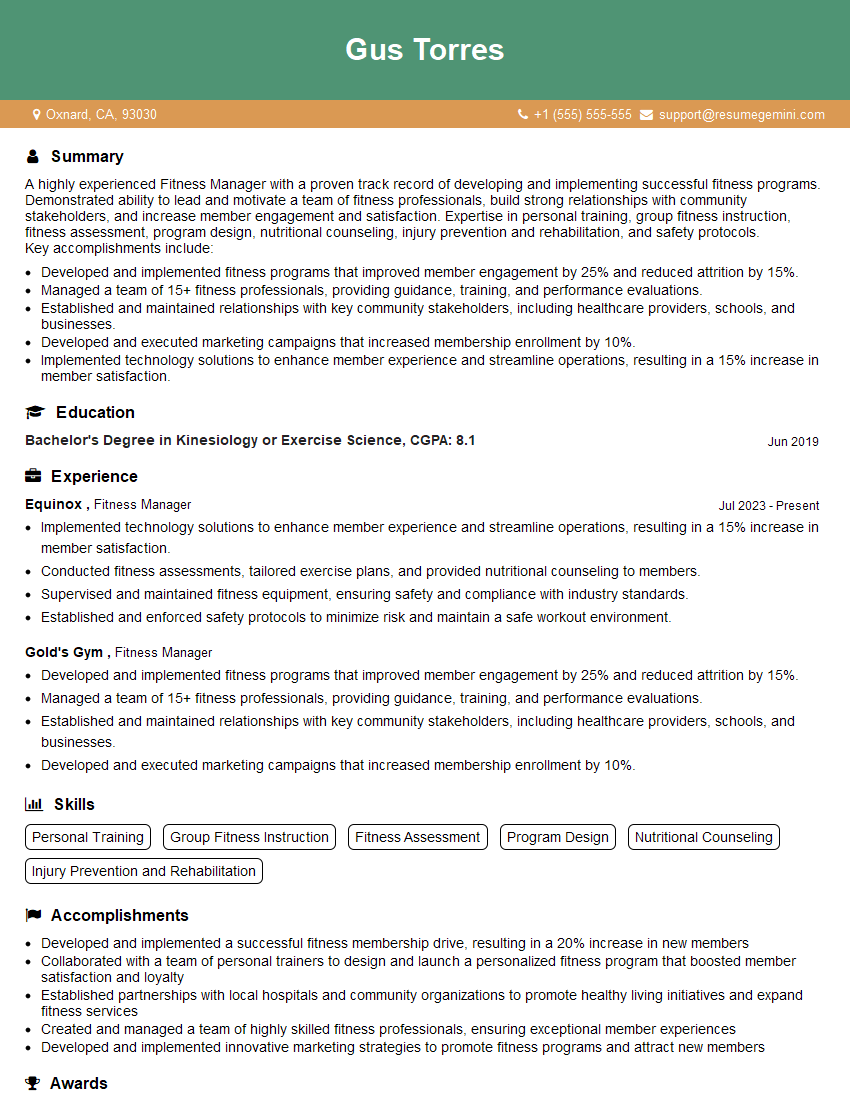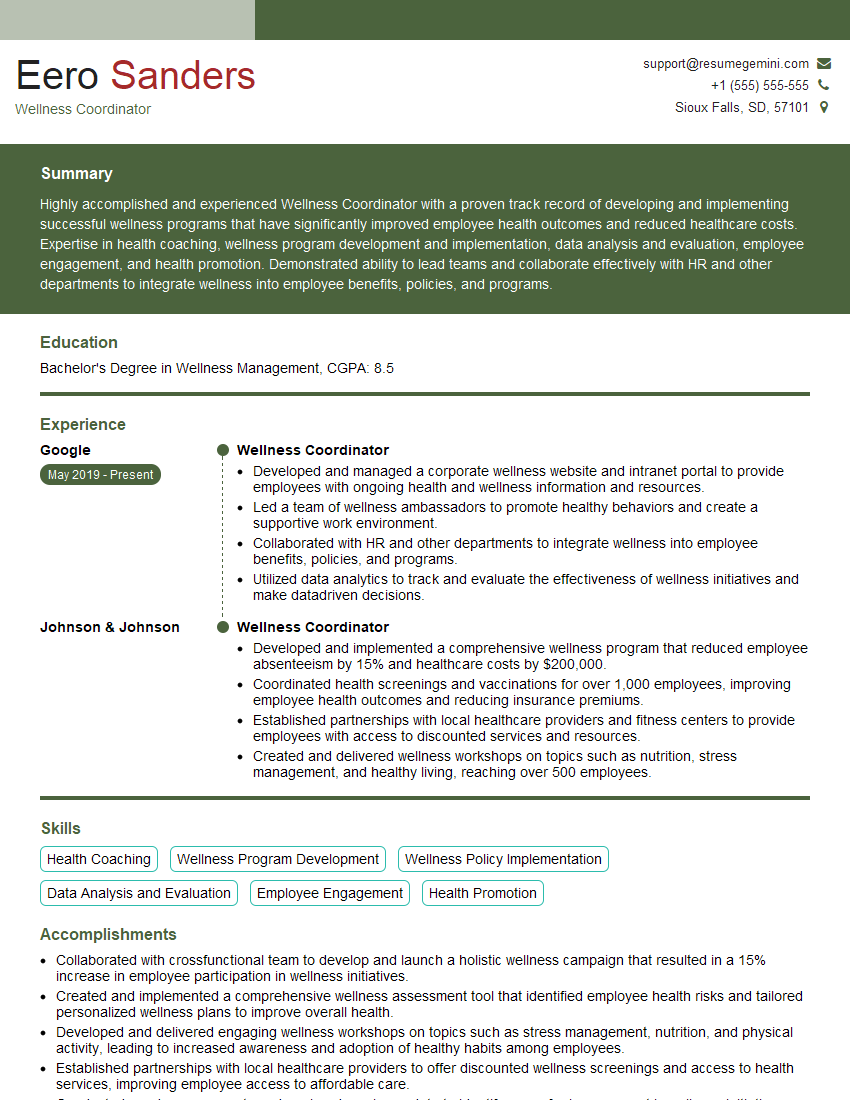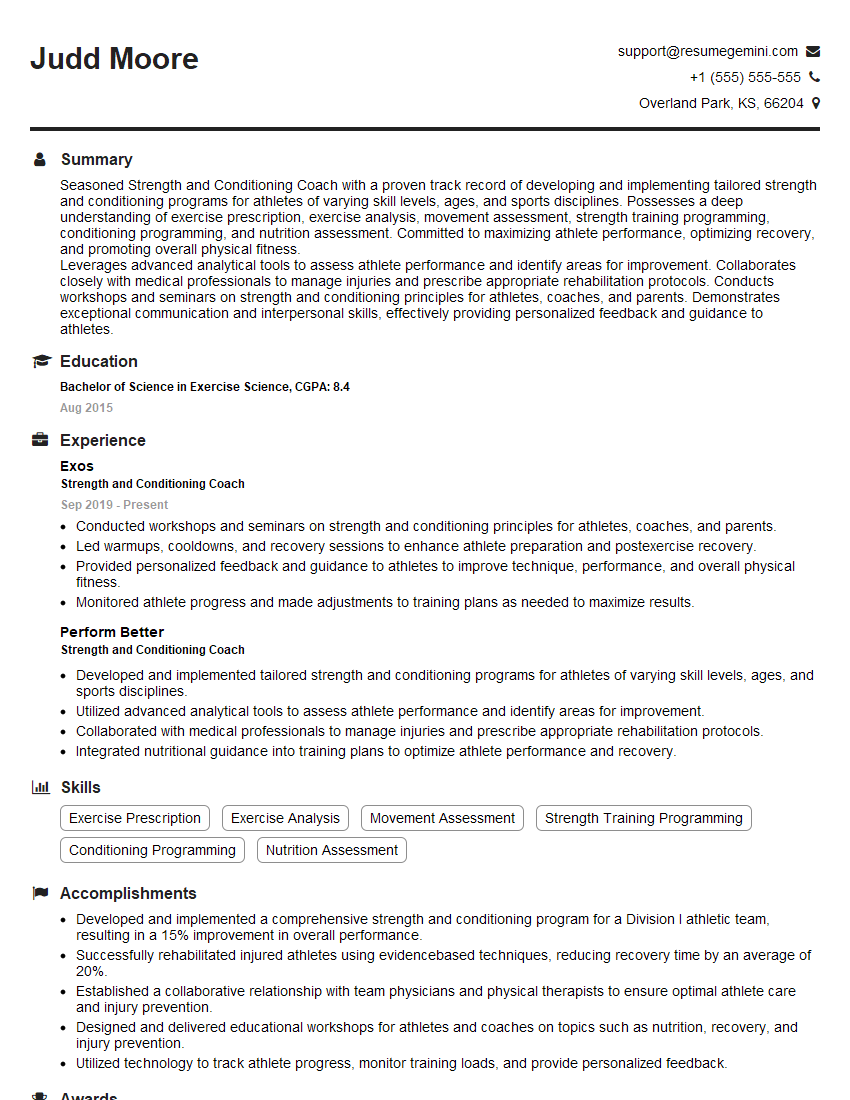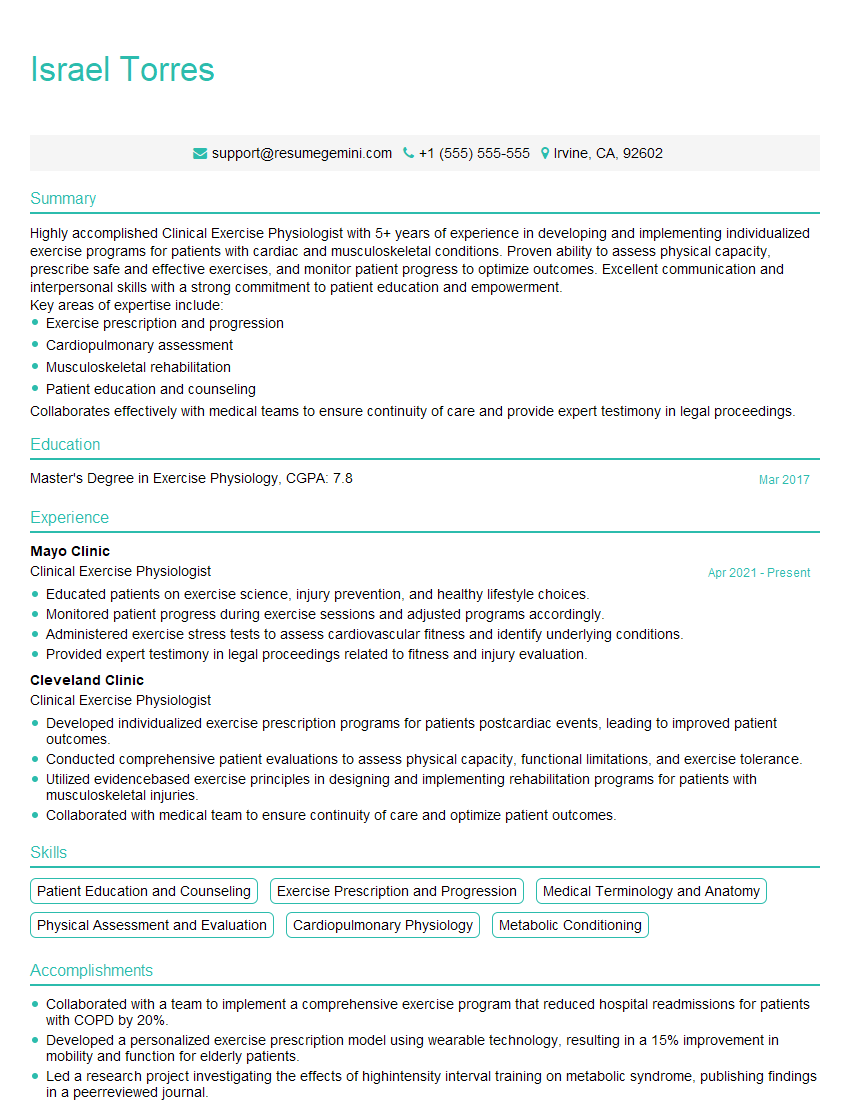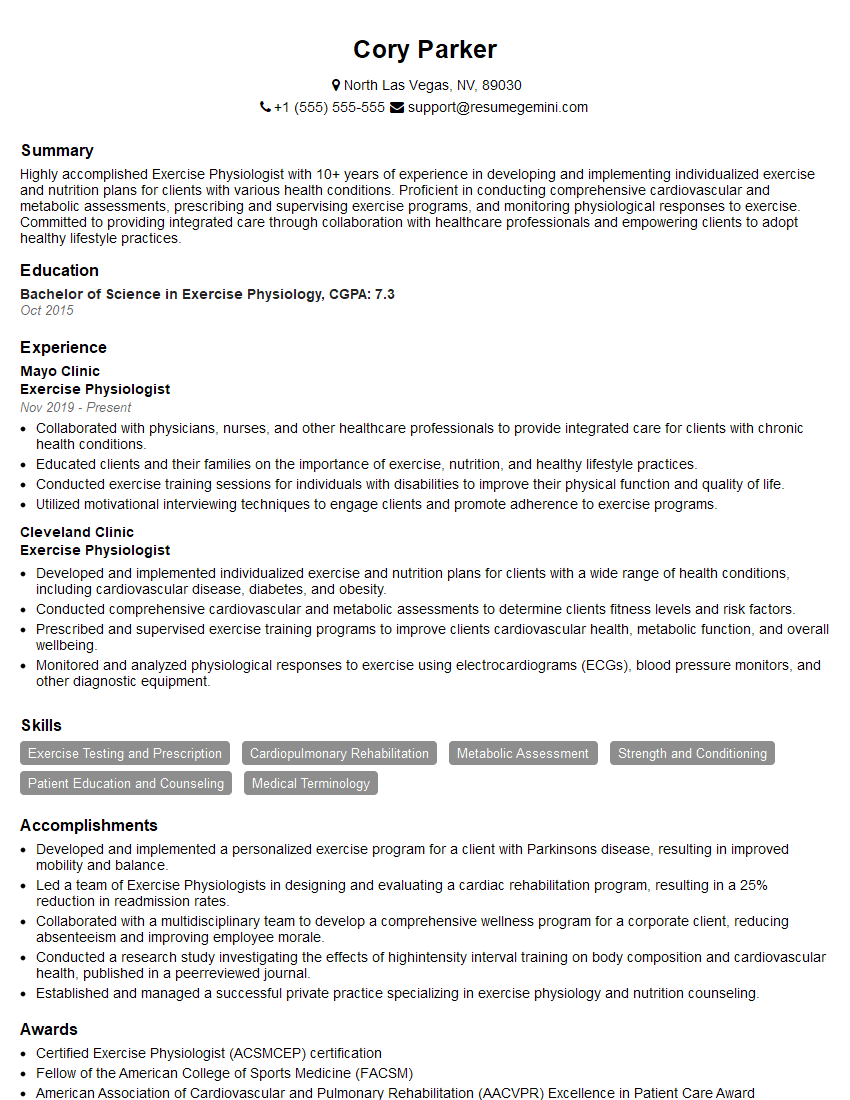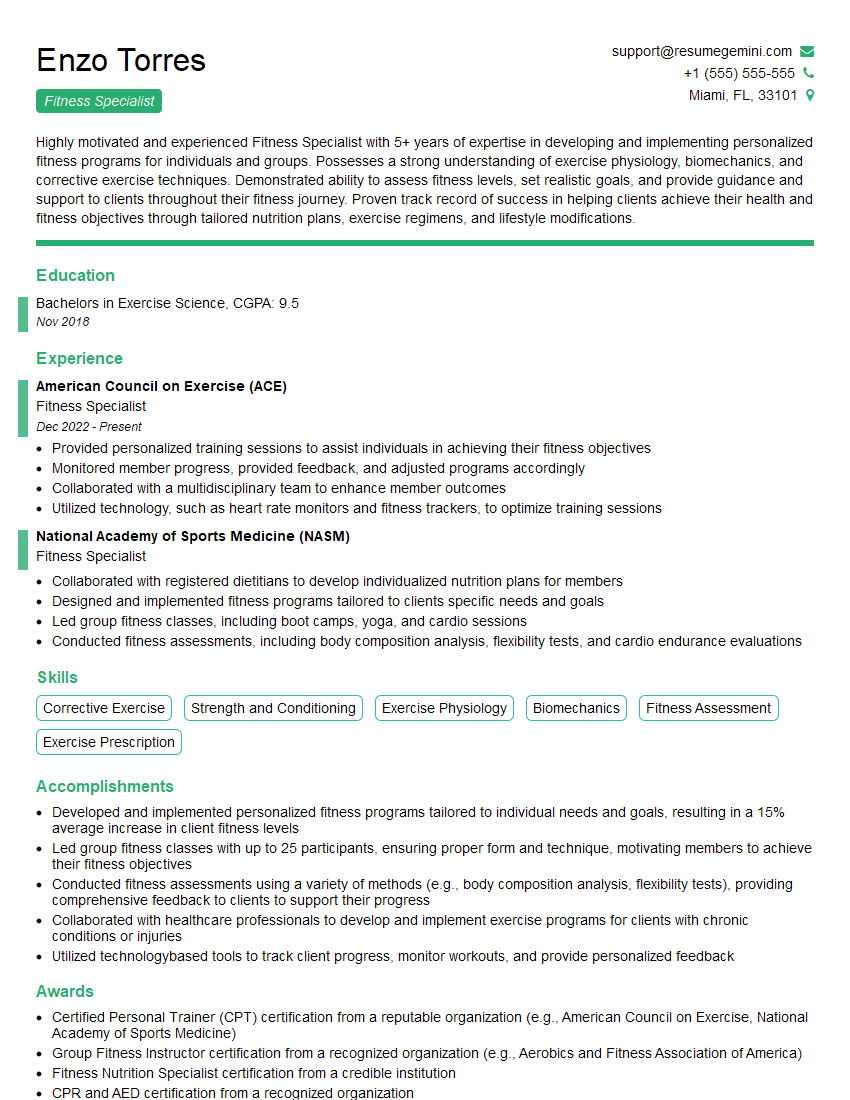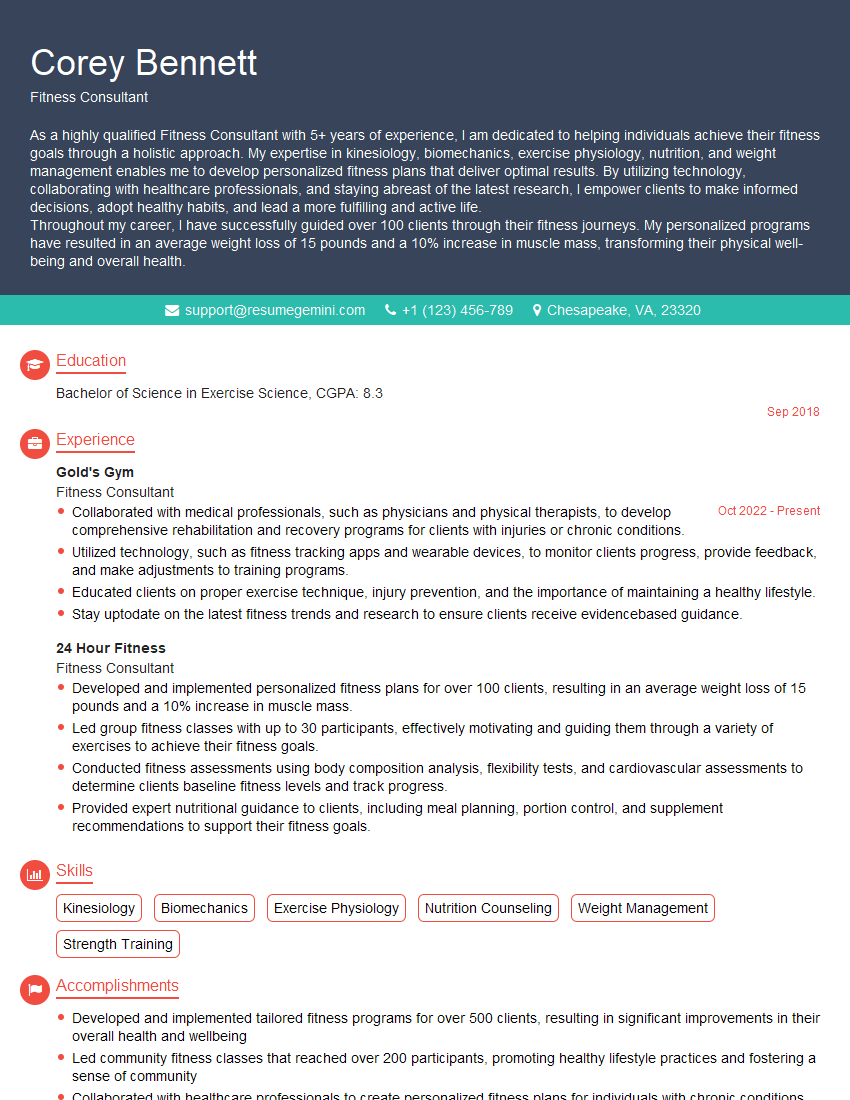Preparation is the key to success in any interview. In this post, we’ll explore crucial Fitness Assessments interview questions and equip you with strategies to craft impactful answers. Whether you’re a beginner or a pro, these tips will elevate your preparation.
Questions Asked in Fitness Assessments Interview
Q 1. Explain the different types of fitness assessments.
Fitness assessments are crucial for understanding an individual’s current fitness level and designing effective exercise programs. They can be broadly categorized into several types, each focusing on different aspects of fitness.
- Cardiorespiratory Fitness Assessments: These tests evaluate the efficiency of the heart and lungs in delivering oxygen to working muscles. Examples include the VO2 max test (gold standard but requires specialized equipment), the 1.5-mile run test, and the step test. They provide a benchmark for endurance capabilities.
- Muscular Strength and Endurance Assessments: These assess the ability of muscles to exert force (strength) and sustain effort over time (endurance). Common assessments include one-repetition maximum (1RM) tests for various exercises (e.g., bench press, squat), push-up tests, and sit-up tests. These help determine muscular fitness levels.
- Flexibility Assessments: These measure the range of motion around a joint. Common methods include sit-and-reach tests, goniometry (using a tool to measure joint angles), and the shoulder flexibility test. Assessing flexibility is important for preventing injuries and improving mobility.
- Body Composition Assessments: These determine the proportion of fat mass to fat-free mass (muscle, bone, water). Methods include skinfold calipers, bioelectrical impedance analysis (BIA), underwater weighing (hydrostatic weighing), and DEXA scans. Body composition is a key indicator of overall health and fitness.
- Balance and Functional Fitness Assessments: These assess the ability to maintain equilibrium and perform everyday activities. Examples include the single-leg stance test, the timed up-and-go test, and functional movement screens (e.g., FMS). These are critical for assessing fall risk and overall functional capacity.
Q 2. Describe the components of a comprehensive fitness assessment.
A comprehensive fitness assessment goes beyond just one or two tests. It should encompass a holistic view of the individual’s fitness status, including:
- Health History Questionnaire: This gathers information about pre-existing medical conditions, medications, injuries, and lifestyle factors. It’s crucial for identifying contraindications to certain exercises and tailoring the assessment accordingly.
- Resting Measurements: This includes resting heart rate, blood pressure, and body weight. These provide baseline data and help monitor changes over time.
- Cardiorespiratory Fitness Assessment: As described previously, this assesses the efficiency of the cardiovascular system.
- Muscular Strength and Endurance Assessment: As described previously, this assesses muscular fitness levels.
- Flexibility Assessment: As described previously, this evaluates joint range of motion.
- Body Composition Assessment: As described previously, this measures body fat percentage.
- Balance and Functional Fitness Assessment: As described previously, this assesses balance and functional abilities.
- Postural Assessment: This looks for muscle imbalances and postural deviations which may increase risk of injury.
- Discussion and Goal Setting: This involves a discussion with the client to understand their goals, motivations, and limitations, thus creating a personalized exercise plan.
Think of it like building a house – you need a strong foundation (health history), solid walls (cardio, strength, flexibility), and a functional layout (balance, posture) to create a complete structure (overall fitness).
Q 3. What are the key considerations when selecting fitness assessment tools?
Selecting the right assessment tools depends on various factors:
- Client’s Fitness Level and Goals: A beginner will need different assessments than a seasoned athlete. A client aiming for weight loss might prioritize body composition assessments, while a runner may focus on cardiorespiratory fitness.
- Availability of Equipment and Resources: Some tests require expensive equipment (e.g., DEXA scan, VO2 max testing), while others can be performed with minimal equipment (e.g., push-ups, sit-and-reach).
- Test Validity and Reliability: Choose tests that have been scientifically validated and shown to be reliable (consistent results over time and across different testers). For example, skinfold measurements taken by an experienced technician are more reliable than those taken by a novice.
- Safety: Prioritize client safety. Choose tests that are appropriate for the client’s health status and minimize the risk of injury.
- Time Constraints: Consider the time available for the assessment. A comprehensive assessment may require more time than a brief screening.
For example, if assessing an older adult client concerned about falls, functional fitness tests like the Timed Up and Go would be more relevant than a maximal oxygen uptake test.
Q 4. How do you interpret and analyze the results of a fitness assessment?
Interpreting and analyzing assessment results involves several steps:
- Compare to Norms: Compare the client’s scores to age- and sex-specific norms or standards. This helps determine their relative fitness level compared to others in their demographic.
- Identify Strengths and Weaknesses: Pinpoint areas where the client excels and areas needing improvement. For instance, a client might have excellent cardiorespiratory fitness but poor flexibility.
- Consider Individual Variability: Recognize that individuals may have different strengths and weaknesses. A comprehensive picture is obtained by combining results from different tests.
- Track Progress Over Time: Re-assess clients periodically to monitor their progress and adjust their training program as needed. This allows for a data-driven approach to personalize the client’s fitness journey.
- Combine with Subjective Data: Integrate the objective results from the assessments with the client’s subjective feedback (feelings, experiences) and goals. This allows for a more holistic understanding of their fitness journey.
For instance, if a client’s body fat percentage is high, but their cardiorespiratory fitness is good, it suggests that a focus on nutrition and strength training might be beneficial in addition to cardio.
Q 5. How do you adapt fitness assessments for clients with different health conditions or limitations?
Adapting assessments for clients with health conditions or limitations requires careful consideration. It’s crucial to:
- Consult with Healthcare Professionals: Always consult with the client’s physician or physical therapist before conducting assessments, particularly if they have significant health conditions. This is essential for both safety and appropriateness of the chosen assessments.
- Modify Tests as Needed: Adapt tests to reduce the intensity or modify the movement pattern to suit the client’s capabilities. For example, instead of a traditional push-up, a client with shoulder problems might perform wall push-ups or incline push-ups.
- Use Alternative Assessments: In some cases, standard tests may not be suitable, and alternative assessments need to be used. For instance, a client with mobility limitations might have their flexibility assessed using a different method than a sit-and-reach test.
- Focus on Functional Fitness: Emphasize functional fitness assessments for clients with mobility issues, as these tests evaluate their ability to perform everyday tasks. This helps build a personalized training program centered on practical mobility.
- Monitor Client Response: Closely monitor the client’s response during the assessment to ensure their safety and comfort. If they experience any discomfort or pain, stop the assessment immediately.
Example: For a client with osteoarthritis, you might replace a squat with a chair stand test, modifying the assessment to reflect their limitations while still gathering useful data.
Q 6. What are the ethical considerations involved in fitness assessments?
Ethical considerations in fitness assessments are paramount. These include:
- Informed Consent: Obtain informed consent from the client before conducting any assessments. This ensures they fully understand the purpose, procedures, risks, and benefits of the assessment.
- Confidentiality: Maintain strict confidentiality regarding the client’s personal information and assessment results. Only share information with authorized personnel (e.g., referring physician).
- Competence: Only conduct assessments for which you are adequately trained and qualified. Don’t attempt assessments beyond your expertise.
- Objectivity: Conduct assessments objectively and avoid bias. Base your interpretations solely on the assessment results and client information.
- Professional Boundaries: Maintain professional boundaries at all times and avoid any actions that could be interpreted as inappropriate or exploitative.
- Cultural Sensitivity: Be mindful of cultural differences and adjust your approach accordingly. Consider factors such as beliefs, values and customs that might impact a client’s experience during a fitness assessment.
Maintaining ethical conduct builds trust and ensures that fitness assessments are used responsibly and ethically to enhance the well-being of clients.
Q 7. How do you ensure the accuracy and reliability of fitness assessments?
Ensuring accuracy and reliability involves several steps:
- Proper Training and Certification: Seek appropriate training and certifications in fitness assessment techniques. This ensures competency and adherence to best practices.
- Standardized Procedures: Follow standardized procedures for each assessment to minimize variability. Precise instructions and consistent methods are crucial for achieving repeatable results.
- Calibration of Equipment: Regularly calibrate any equipment used in assessments to ensure accuracy (e.g., scales, skinfold calipers, BIA devices). This guarantees that measurements are consistent and reliable.
- Test-Retest Reliability: Conduct test-retest assessments on a sample population or the individual to determine the reliability of the testing methods used. This helps to confirm the consistency of the measurements.
- Inter-rater Reliability: If multiple testers are involved, assess the inter-rater reliability to ensure consistent results across different testers. This involves comparing the results obtained by different assessors to check for agreement.
- Control Environmental Factors: Control environmental factors that could influence assessment results, such as temperature, humidity, and time of day. Standardized conditions are crucial for accurate and reliable results.
For instance, using a standardized protocol for skinfold measurements, such as taking measurements at the same sites on the body and using the same caliper each time, will enhance the reliability and consistency of the assessment.
Q 8. Describe your experience administering various fitness tests (e.g., VO2 max, body composition, flexibility).
My experience encompasses a wide range of fitness assessments, tailored to individual needs and goals. I’m proficient in administering tests measuring cardiovascular fitness (VO2 max), using methods like graded exercise tests (GXT) on treadmills or cycle ergometers, and analyzing the data to determine aerobic capacity. For body composition analysis, I utilize several methods, including skinfold caliper measurements (using multiple sites and standard formulas like Jackson-Pollock), bioelectrical impedance analysis (BIA), and, where available, DEXA scans for a more precise assessment of fat mass and lean mass. Flexibility assessments involve range-of-motion tests, such as sit-and-reach for hamstring flexibility, and shoulder and hip flexibility assessments using goniometers for objective measurements. I also incorporate functional movement screens like the FMS (Functional Movement Screen) to identify movement limitations and potential injury risks. Each assessment is chosen based on the client’s fitness level, goals, and any pre-existing conditions. For example, a sedentary individual might start with simpler tests like a 1-mile walk test, while a seasoned athlete might require a more advanced VO2 max test.
Q 9. How do you communicate assessment results effectively to clients?
Communicating assessment results is crucial and requires a sensitive, client-centered approach. I avoid overwhelming clients with technical jargon. Instead, I translate the data into clear, understandable language, focusing on what the results mean for their health and fitness goals. For instance, instead of saying “Your VO2 max is 35 ml/kg/min,” I might say, “Your cardiovascular fitness is good, but there’s room for improvement to enhance your endurance.” I use visual aids like graphs and charts to illustrate progress and highlight key areas for focus. A critical part of this communication is actively listening to the client’s questions and concerns, addressing them honestly and openly. I always frame the results positively, emphasizing their strengths and focusing on actionable steps they can take to improve. I provide a written summary of the results along with personalized recommendations, ensuring they understand the rationale behind the plan.
Q 10. Explain the importance of client education in the context of fitness assessments.
Client education is paramount. Understanding the “why” behind the assessment and the results is vital for client buy-in and adherence to a fitness plan. I explain the purpose of each test, how it measures specific aspects of fitness, and what the results indicate about their overall health and fitness status. I discuss the implications of their results in terms of their risk factors for chronic diseases like heart disease or diabetes. For example, if a client has low muscle mass, I explain the health benefits of strength training, including increased bone density, improved metabolism, and reduced risk of falls. This empowers them to make informed decisions about their health and actively participate in the process. Open communication and fostering a collaborative approach are key in ensuring clients understand and are invested in their fitness journey.
Q 11. How do you handle situations where a client’s results are unexpected or concerning?
Unexpected or concerning results require a calm and professional response. My first step is to carefully review the data to ensure accuracy and identify any potential errors in the testing procedure. I then schedule a follow-up meeting to discuss the results in detail, providing a supportive and non-judgmental environment. I avoid making assumptions and instead ask open-ended questions to understand the client’s perspective and any underlying factors that might have contributed to the unexpected findings. Depending on the results (e.g., significantly low blood pressure, signs of potential cardiac issues), I might recommend further medical evaluation by their physician. This involves providing a referral to the appropriate healthcare professional and collaborating with them to ensure the client receives comprehensive care. My role is to support and guide, prioritizing the client’s overall well-being.
Q 12. How do you design a personalized fitness plan based on the results of a fitness assessment?
A personalized fitness plan is built upon the foundation of the assessment results. I use a holistic approach, considering not only the client’s fitness level but also their goals, preferences, limitations (including any injuries or medical conditions), and lifestyle. For instance, if a client’s assessment reveals low cardiovascular fitness and a goal of running a 5k, the plan will gradually increase their aerobic capacity through a structured program incorporating running intervals, cross-training activities, and progressive overload. If strength training is needed, the plan will incorporate exercises targeting major muscle groups, with a focus on proper form and progressive resistance. The plan will also address nutritional aspects, considering the client’s dietary preferences and needs to support their fitness goals. Regular monitoring and adjustments based on progress are crucial to ensure the plan remains effective and motivating.
Q 13. How do you motivate clients to adhere to their fitness plans?
Motivation is a key factor in adherence. I build rapport with clients, creating a trusting and supportive relationship. I set realistic and achievable goals, celebrating small victories along the way. I actively listen to their concerns and adjust the plan as needed, ensuring it remains enjoyable and sustainable. Utilizing various motivational techniques, such as goal-setting strategies (SMART goals), progress tracking, positive reinforcement, and regular check-ins, are vital. I also encourage social support by suggesting group fitness classes or workout buddies. By emphasizing the positive impact of exercise on their physical and mental health, I aim to empower clients to take ownership of their fitness journey and make it a sustainable lifestyle change, rather than a short-term commitment.
Q 14. How frequently should fitness assessments be conducted?
The frequency of fitness assessments depends on several factors, including the client’s goals, fitness level, and any pre-existing conditions. For individuals starting a new fitness program, initial assessments are crucial to establish a baseline and create a personalized plan. Follow-up assessments are typically scheduled every 4-8 weeks to monitor progress, make necessary adjustments to the plan, and maintain motivation. For athletes or individuals with specific training goals, more frequent assessments may be needed (e.g., every 2-4 weeks). For individuals with chronic health conditions, more frequent assessments may also be necessary to ensure their safety and effectiveness of the training program. The frequency is always decided in collaboration with the client, ensuring regular monitoring and effective progress tracking.
Q 15. Describe your experience with different fitness assessment technologies (e.g., wearable devices, software).
My experience with fitness assessment technologies spans a wide range, encompassing both traditional methods and cutting-edge digital tools. I’m proficient in using wearable devices like Fitbits and Apple Watches to track activity levels, sleep patterns, and heart rate variability. This data provides valuable insights into a client’s baseline fitness and adherence to exercise programs. I also have extensive experience with software platforms such as MyZone, which allows for real-time monitoring of heart rate during workouts, and various body composition analysis software that integrate with impedance scales or DEXA scans.
Furthermore, I’m skilled in utilizing more traditional assessment methods. This includes manual methods like measuring resting heart rate, blood pressure, and performing various functional movement screens like the FMS (Functional Movement Screen) or Y-Balance Test. Combining these technologies and approaches provides a holistic understanding of a client’s fitness profile, leading to more effective and individualized training plans.
For example, I recently worked with a client who was using a fitness tracker showing low activity levels despite reporting regular exercise. By combining this data with a thorough physical assessment, we discovered underlying biomechanical inefficiencies hindering their progress. This highlighted the importance of a multifaceted approach using both technological and traditional assessment methods.
Career Expert Tips:
- Ace those interviews! Prepare effectively by reviewing the Top 50 Most Common Interview Questions on ResumeGemini.
- Navigate your job search with confidence! Explore a wide range of Career Tips on ResumeGemini. Learn about common challenges and recommendations to overcome them.
- Craft the perfect resume! Master the Art of Resume Writing with ResumeGemini’s guide. Showcase your unique qualifications and achievements effectively.
- Don’t miss out on holiday savings! Build your dream resume with ResumeGemini’s ATS optimized templates.
Q 16. How do you maintain confidentiality and privacy when handling client fitness data?
Maintaining client confidentiality and privacy is paramount. I adhere to strict ethical guidelines and relevant data protection regulations (like HIPAA in the US or GDPR in Europe). All client data, whether collected through wearable devices, software, or manual assessments, is stored securely using password-protected electronic files and physical files in locked cabinets. Client information is only accessed by authorized personnel on a need-to-know basis.
I always obtain informed consent from each client before initiating any assessment or collecting data. This ensures transparency and empowers clients to understand how their data will be used and protected. Data is anonymized whenever possible for research or educational purposes, ensuring individual identities remain confidential. I regularly review and update my security protocols to stay abreast of emerging threats and best practices in data protection.
Q 17. How do you stay current with the latest research and best practices in fitness assessments?
Staying current in the field requires a multi-pronged approach. I regularly read peer-reviewed journals like the Journal of Strength and Conditioning Research and the Medicine & Science in Sports & Exercise. I also actively participate in professional development opportunities, attending conferences and workshops organized by organizations such as the American College of Sports Medicine (ACSM) and the National Strength and Conditioning Association (NSCA).
Furthermore, I maintain memberships in professional organizations to receive regular updates on the latest research and best practices. I actively engage with online communities and forums, participating in discussions and learning from the experiences of other professionals in the field. This ongoing learning ensures that I remain proficient in the most current and evidence-based assessment methods.
Q 18. What are the limitations of various fitness assessment methods?
Various fitness assessment methods have inherent limitations. For instance, wearable devices, while convenient, can be inaccurate due to factors like sensor placement and individual variations in physiological responses. They may not capture the full picture of fitness, as they often focus primarily on cardio-respiratory fitness and overlook other crucial aspects such as strength, flexibility, and balance.
Anthropometric measurements, such as body mass index (BMI), can be misleading as they don’t distinguish between fat mass and muscle mass. Similarly, functional movement screens can be subjective, depending on the assessor’s interpretation. The validity and reliability of different tests also vary depending on the population being tested and the specific equipment used. It’s crucial to understand these limitations and interpret the results cautiously, considering the context and using multiple assessment tools to obtain a comprehensive view.
Q 19. Explain your proficiency in using various anthropometric measures.
I’m highly proficient in using various anthropometric measures, including height, weight, body mass index (BMI), body fat percentage (using methods like skinfold calipers, bioelectrical impedance analysis (BIA), and underwater weighing), waist circumference, and hip circumference. I understand the importance of standardized procedures to ensure accuracy and reliability in these measurements. I’m trained in the correct techniques for taking skinfold measurements at specific anatomical sites, using calibrated calipers and adhering to established protocols to minimize measurement error.
I also understand the limitations of each method and select the most appropriate technique based on the individual’s characteristics, available resources, and the assessment’s purpose. For example, I might use BIA for a quick and convenient assessment of body composition, while underwater weighing would be more suitable for a more precise measurement when resources permit. I carefully document all measurements, ensuring consistency and facilitating the tracking of changes over time.
Q 20. How do you ensure proper safety precautions during fitness assessments?
Safety is always my top priority during fitness assessments. Before any assessment, I conduct a thorough health screening to identify any potential risks or contraindications. This includes reviewing the client’s medical history, current medications, and any previous injuries. I explain all procedures clearly to the client and obtain their informed consent before proceeding.
During the assessment, I create a safe and comfortable environment. I utilize appropriate equipment and ensure it is properly calibrated and maintained. I closely monitor the client’s heart rate, blood pressure, and overall well-being throughout the assessment, and I’m prepared to stop the assessment immediately if any adverse effects are observed. Clients are always instructed to communicate any discomfort or unusual sensations immediately.
Q 21. Describe a time you had to troubleshoot a problem during a fitness assessment.
During a recent fitness assessment, I encountered a problem with a client’s wearable device. The heart rate monitor on their smartwatch was consistently giving erratic readings. Instead of relying solely on the device, I immediately switched to a manual method, using a chest strap heart rate monitor to obtain a reliable measurement. This ensured that the data collected was accurate and allowed us to proceed with the assessment without compromising the integrity of the results.
After the assessment, I investigated the faulty smartwatch readings. I found that the client had recently applied a thick layer of lotion to their wrist, which interfered with the device’s sensors. I educated the client about this issue and advised them to avoid applying lotions or creams directly to their wrists when wearing the device. This incident emphasized the importance of having backup methods and carefully considering potential sources of error during fitness assessments.
Q 22. How do you handle client resistance or reluctance to participate in a fitness assessment?
Addressing client resistance to fitness assessments requires a multifaceted approach built on trust and understanding. It begins with open communication and empathy. I start by explaining the why behind the assessment – how it’s not a judgment but a tool to create a personalized plan that maximizes their results and minimizes risk of injury. I emphasize that the assessment is a collaborative process, not a test.
For example, if a client expresses concern about their fitness level, I might share success stories of clients who started with similar concerns and achieved significant progress. I also offer choices in the assessment process, allowing them to select some tests over others depending on their comfort level. This empowers them and demonstrates respect for their individual preferences. If apprehension remains, I may offer a shorter, less intense assessment initially and gradually expand the scope over time.
Sometimes, addressing underlying concerns is key. If a client seems anxious, I might inquire about their past experiences with fitness or health professionals. This could uncover underlying trauma or negative perceptions that need to be acknowledged and addressed. Building rapport and trust is paramount in overcoming resistance.
Q 23. How do you adapt your assessment approach to different client demographics?
Adapting fitness assessments to different client demographics is crucial for effective and safe practice. Age, gender, physical abilities, and cultural background significantly influence assessment design and interpretation. For older adults, I might modify assessments to reduce the risk of falls or injury, perhaps emphasizing functional tests like chair stands and gait speed over maximal strength tests.
With younger clients, I might incorporate assessments that are more game-like or fun to encourage engagement. For clients with disabilities, I focus on functional assessments that evaluate their specific needs and capabilities. I may use alternative methods, like measuring range of motion with a goniometer instead of relying solely on traditional exercises. For example, a client with arthritis may not be able to perform push-ups, so an isometric strength test (holding a plank position) might be more appropriate.
Cultural sensitivity is paramount. I consider factors such as clothing preferences and communication styles when interacting with clients from different backgrounds. Understanding the client’s health beliefs and preferences is critical. The language used should be clear, concise, and respectful, avoiding medical jargon where possible.
Q 24. What are the specific legal and regulatory requirements for conducting fitness assessments?
Legal and regulatory requirements for conducting fitness assessments vary depending on location and professional certifications. However, several key principles apply universally. Primarily, maintaining client confidentiality is paramount. I adhere to HIPAA guidelines (in the US) or equivalent regulations in other jurisdictions. This includes securely storing assessment data and ensuring only authorized individuals have access. Informed consent is also critical. Clients must understand the purpose, procedures, risks, and benefits of the assessment before proceeding. I provide written information and obtain their signed consent before initiating any testing.
Professional liability insurance is essential to protect against potential claims related to negligence or injury during the assessment process. Staying up-to-date on best practices and continuing professional education ensures I am competent and compliant. Following established safety protocols during testing, such as appropriate warm-ups, is a must. Finally, accurate documentation is paramount, not just for legal reasons but also for effective client care.
Q 25. How do you integrate fitness assessments into a broader health and wellness program?
Fitness assessments are the cornerstone of any comprehensive health and wellness program. They provide the baseline data needed to establish realistic goals, design appropriate interventions, and track progress. The assessment informs the entire process. It helps to identify both strengths and weaknesses, helping tailor programs to maximize individual outcomes. For example, if an assessment reveals low cardiovascular fitness, I will incorporate cardiovascular training into the program. If muscular strength is deficient, I include resistance training.
The data from the assessments is used for goal setting, measuring progress, modifying the program based on client’s response, and overall program evaluation. The process is iterative; regular reassessments allow for adjustments, ensuring that the program remains relevant and effective. This continuous feedback loop optimizes the client’s journey towards their health and fitness goals.
Q 26. What is your experience with documenting and reporting fitness assessment data?
My experience in documenting and reporting fitness assessment data involves using both electronic and paper-based methods, depending on client preference and practice setting. Electronic health records (EHRs) provide a secure and organized system for storing data. I typically use spreadsheets or dedicated fitness software to record and analyze data. This enables efficient tracking of progress over time and the generation of comprehensive reports.
For each client, I maintain a detailed record of the assessment procedures, the results of each test (including units of measurement), and my interpretations. I also document any client comments, concerns, or modifications made to the assessment. Reporting involves summarizing these findings in a clear and concise manner, using graphs and charts when appropriate, to aid the client’s understanding. I always maintain patient confidentiality and ensure compliance with relevant data privacy regulations.
Q 27. Describe your experience with creating and using progress monitoring tools.
I utilize a variety of progress monitoring tools, adapting them to the client’s goals and preferences. These tools include visual progress charts (bar graphs, line graphs), tracking sheets for weight, body measurements, and lifestyle habits. More sophisticated methods may involve wearable technology that tracks activity levels, sleep, and other relevant data.
For instance, I might use a simple spreadsheet to track a client’s weight loss, or a fitness app to monitor their exercise progress. I regularly review this data with my clients, discussing progress, setbacks, and making adjustments as needed. These tools are more than just data trackers; they are important motivational tools that provide a visual representation of a client’s achievements, encouraging adherence to their fitness plan. The key is to choose and use these tools in a collaborative manner with the client; it’s about working with them to design a monitoring system that works best for their personality and needs.
Q 28. How do you differentiate between subjective and objective data in fitness assessment?
Differentiating between subjective and objective data is crucial for a balanced and accurate assessment. Objective data is quantifiable and measurable. Examples include height, weight, blood pressure, resting heart rate, VO2 max, and results from strength tests (measured in pounds or kilograms). These data points are based on objective measurements and are less prone to bias.
Subjective data, on the other hand, relies on the client’s perception and self-reporting. This includes information gathered through questionnaires, interviews, or rating scales. Examples are perceived exertion levels, pain scales, sleep quality, and lifestyle habits. While subjective data provides valuable insights into the client’s experience, it is important to acknowledge that it can be influenced by factors such as mood, memory, and individual biases. A comprehensive fitness assessment should integrate both types of data for a holistic understanding of the client’s fitness level and overall well-being. Combining objective and subjective data gives a much richer and accurate picture.
Key Topics to Learn for Fitness Assessments Interview
- Understanding Different Assessment Types: Explore various fitness assessment methods, including muscular strength and endurance tests, cardiovascular assessments, flexibility evaluations, and body composition analysis. Consider the advantages and limitations of each.
- Practical Application of Assessment Results: Learn how to interpret assessment data to create individualized fitness programs, identify areas for improvement, and track client progress. Practice analyzing hypothetical scenarios and suggesting appropriate interventions.
- Designing Effective Fitness Programs: Understand the principles of exercise prescription, including the FITT principle (Frequency, Intensity, Time, Type). Learn how to tailor programs to diverse populations, considering age, health status, and fitness levels.
- Safety and Risk Management: Master the identification and mitigation of potential risks associated with fitness assessments and exercise programs. Understand appropriate safety precautions and emergency procedures.
- Technology and Data Analysis: Explore the use of technology in fitness assessment, such as wearable fitness trackers and software for data analysis. Learn how to interpret and utilize this data effectively.
- Client Communication and Motivation: Develop strategies for effective communication with clients, providing clear explanations of assessment results and motivating them to adhere to their fitness plans.
- Legal and Ethical Considerations: Understand the legal and ethical implications of conducting fitness assessments, including informed consent, confidentiality, and professional boundaries.
Next Steps
Mastering fitness assessments is crucial for career advancement in the fitness industry, opening doors to specialized roles and higher earning potential. A strong resume is your key to unlocking these opportunities. Creating an ATS-friendly resume significantly increases your chances of getting noticed by recruiters. We strongly recommend using ResumeGemini to build a professional and impactful resume that highlights your skills and experience effectively. ResumeGemini provides examples of resumes tailored to Fitness Assessments, helping you showcase your expertise in the best possible light. Take the next step towards your dream career today!
Explore more articles
Users Rating of Our Blogs
Share Your Experience
We value your feedback! Please rate our content and share your thoughts (optional).
What Readers Say About Our Blog
Hello,
We found issues with your domain’s email setup that may be sending your messages to spam or blocking them completely. InboxShield Mini shows you how to fix it in minutes — no tech skills required.
Scan your domain now for details: https://inboxshield-mini.com/
— Adam @ InboxShield Mini
Reply STOP to unsubscribe
Hi, are you owner of interviewgemini.com? What if I told you I could help you find extra time in your schedule, reconnect with leads you didn’t even realize you missed, and bring in more “I want to work with you” conversations, without increasing your ad spend or hiring a full-time employee?
All with a flexible, budget-friendly service that could easily pay for itself. Sounds good?
Would it be nice to jump on a quick 10-minute call so I can show you exactly how we make this work?
Best,
Hapei
Marketing Director
Hey, I know you’re the owner of interviewgemini.com. I’ll be quick.
Fundraising for your business is tough and time-consuming. We make it easier by guaranteeing two private investor meetings each month, for six months. No demos, no pitch events – just direct introductions to active investors matched to your startup.
If youR17;re raising, this could help you build real momentum. Want me to send more info?
Hi, I represent an SEO company that specialises in getting you AI citations and higher rankings on Google. I’d like to offer you a 100% free SEO audit for your website. Would you be interested?
Hi, I represent an SEO company that specialises in getting you AI citations and higher rankings on Google. I’d like to offer you a 100% free SEO audit for your website. Would you be interested?
good
